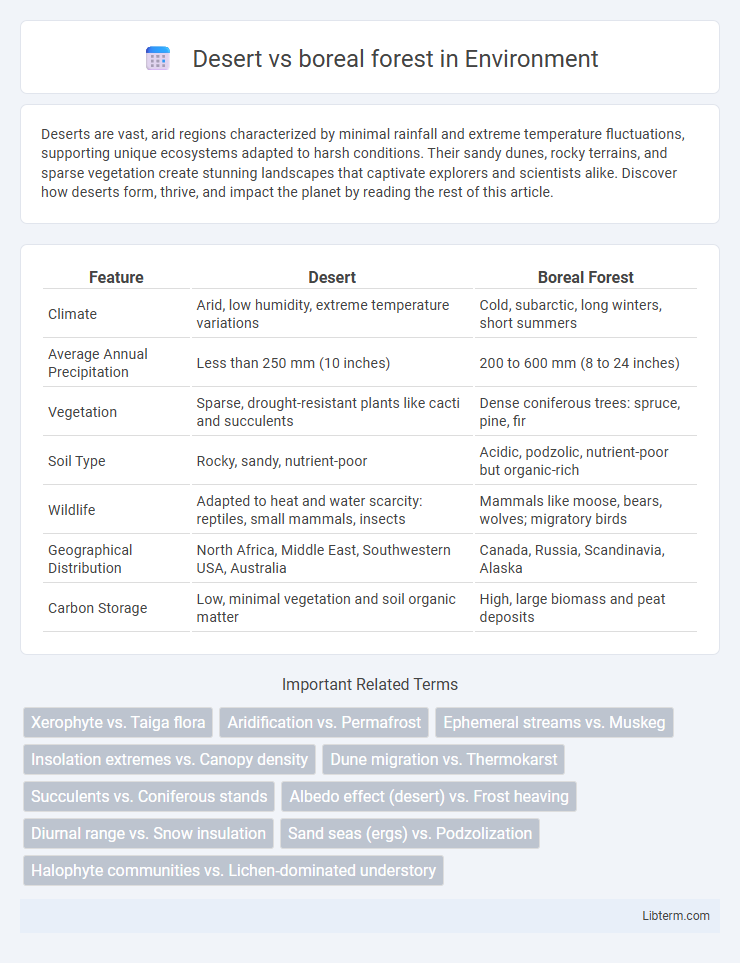Deserts are vast, arid regions characterized by minimal rainfall and extreme temperature fluctuations, supporting unique ecosystems adapted to harsh conditions. Their sandy dunes, rocky terrains, and sparse vegetation create stunning landscapes that captivate explorers and scientists alike. Discover how deserts form, thrive, and impact the planet by reading the rest of this article.
Table of Comparison
| Feature | Desert | Boreal Forest |
|---|---|---|
| Climate | Arid, low humidity, extreme temperature variations | Cold, subarctic, long winters, short summers |
| Average Annual Precipitation | Less than 250 mm (10 inches) | 200 to 600 mm (8 to 24 inches) |
| Vegetation | Sparse, drought-resistant plants like cacti and succulents | Dense coniferous trees: spruce, pine, fir |
| Soil Type | Rocky, sandy, nutrient-poor | Acidic, podzolic, nutrient-poor but organic-rich |
| Wildlife | Adapted to heat and water scarcity: reptiles, small mammals, insects | Mammals like moose, bears, wolves; migratory birds |
| Geographical Distribution | North Africa, Middle East, Southwestern USA, Australia | Canada, Russia, Scandinavia, Alaska |
| Carbon Storage | Low, minimal vegetation and soil organic matter | High, large biomass and peat deposits |
Introduction: Contrasting Desert and Boreal Forest Ecosystems
Desert and boreal forest ecosystems represent two of the planet's most distinct biomes, characterized by stark differences in climate, vegetation, and biodiversity. Deserts experience extreme aridity, intense sunlight, and sparse plant life adapted to water scarcity, while boreal forests dominate cold, subarctic regions with dense coniferous trees adapted to long, harsh winters. These contrasting ecosystems highlight the remarkable adaptability of flora and fauna to diverse environmental conditions and play crucial roles in global ecological balance.
Climate Differences: Aridity vs. Cold Temperatures
Deserts experience extreme aridity with annual precipitation often below 250 millimeters, resulting in sparse vegetation and significant temperature fluctuations between day and night. Boreal forests, or taigas, endure cold temperatures with long, harsh winters averaging below -20degC and moderate precipitation mostly in the form of snow. These climatic contrasts shape distinct ecosystems where deserts prioritize drought tolerance and boreal forests adapt to cold and seasonal snow cover.
Soil Composition and Fertility
Desert soils are typically sandy or rocky with low organic matter, leading to poor fertility and limited water retention, while boreal forest soils, often podzols, contain higher organic content from decaying conifer needles but are acidic and nutrient-poor due to slow decomposition rates. The nutrient cycling in boreal forest soils is slow, resulting in limited availability of nitrogen and phosphorus, whereas desert soils experience minimal microbial activity and nutrient cycling due to extreme aridity. Soil moisture levels and organic input largely dictate fertility differences, making boreal forests more capable of supporting dense vegetation compared to deserts.
Vegetation Adaptations in Deserts and Boreal Forests
Desert vegetation adapts to extreme aridity with succulent plants like cacti that store water, deep root systems to access underground moisture, and reduced leaf surfaces to minimize transpiration. Boreal forests feature coniferous trees such as spruces and pines with needle-like leaves coated in a thick waxy cuticle to reduce water loss and withstand freezing temperatures. Both ecosystems demonstrate specialized adaptations optimizing survival under harsh environmental conditions, including drought in deserts and cold in boreal forests.
Animal Life and Survival Strategies
Deserts host species like kangaroo rats and sidewinder snakes, which exhibit adaptations such as water conservation and nocturnal activity to survive extreme heat and scarcity. Boreal forests support animals including moose, lynx, and snowshoe hares, which rely on thick fur, seasonal camouflage, and food storage to endure cold temperatures and seasonal changes. Both ecosystems showcase unique survival strategies driven by their distinct climate challenges and resource availability.
Water Availability and Conservation Methods
Deserts experience extreme water scarcity with minimal rainfall, necessitating plants and animals to evolve highly efficient water conservation methods such as deep root systems and waxy coatings to reduce evaporation. Boreal forests receive more consistent precipitation and contain vast wetlands and bogs that store water, supporting diverse ecosystems while employing natural water conservation through thick moss layers and dense canopy cover that minimize water loss. Both biomes demonstrate unique adaptations in water availability management, with deserts relying on retention and boreal forests leveraging sustained moisture and natural reservoirs.
Biodiversity Comparison: Species Richness and Endemism
Deserts exhibit lower species richness but harbor a high level of endemism adapted to extreme arid conditions, with specialized flora and fauna such as cacti and desert reptiles. Boreal forests possess greater species richness, dominated by coniferous trees like spruces and firs, supporting diverse mammals, birds, and insects adapted to cold climates. The unique evolutionary pressures in each biome drive distinct biodiversity patterns, with deserts favoring niche specialization and boreal forests promoting broader ecosystem complexity.
Human Impact and Land Use
Human impact on deserts often includes overgrazing, off-road vehicle use, and groundwater extraction, leading to soil degradation and habitat loss. Boreal forests face extensive logging, mining, and infrastructure development, causing fragmentation and altering carbon storage capacity. Land use changes in both biomes contribute significantly to biodiversity decline and influence regional climate patterns.
Climate Change Vulnerability
Deserts exhibit high vulnerability to climate change due to extreme temperature fluctuations and limited water availability, exacerbating drought conditions and threatening endemic species adapted to arid environments. Boreal forests face climate stress from rising temperatures, leading to permafrost thaw, increased wildfire frequency, and shifts in species distribution that disrupt carbon storage and biodiversity. Both ecosystems contribute critically to global carbon cycles but respond differently to climate dynamics, highlighting the need for targeted conservation strategies addressing their unique climate sensitivity.
Conservation Efforts and Future Outlook
Conservation efforts in deserts prioritize protecting fragile ecosystems from overgrazing, water depletion, and habitat fragmentation, employing strategies like sustainable land management and restoration of native vegetation. Boreal forests conservation centers on combating logging impacts and mitigating climate change effects through protected area expansion and sustainable forestry practices. Future outlooks emphasize increased global cooperation, technological advancements, and climate adaptation to preserve biodiversity and ecosystem services in both desert and boreal biomes.
Desert Infographic

 libterm.com
libterm.com